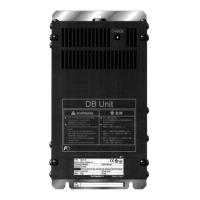4.9 Running the Inverter for Motor Operation Check
4-27
TEST RUN PROCEDURE
Chap 4
4.9 Running the Inverter for Motor Operation Check
After completion of preparations for a test run as described above, start running the inverter for motor operation
check using the following procedure.
If the user configures the function codes wrongly without completely understanding this User's Manual, the motor
may rotate with a torque or at a speed not permitted for the machine.
Accident or injury may result.
If any abnormality is found in the inverter or motor, immediately stop operation and investigate the cause referring
to Chapter 6 “TROUBLESHOOTING.”
4.9.1 Test run procedure
(1) Turn the power ON and check that the reference frequency
*00
Hz is blinking on the LED monitor.
(2) Set a low reference frequency such as 5 Hz, using / keys. (Check that the frequency is blinking on the
LED monitor.)
(3) Press the key to start running the motor in the forward direction. (Check that the reference frequency is lit
on the LED monitor.)
(4) To stop the motor, press the key.
4.9.2 Check points during a test run
(1) Check that the motor is running in the forward direction.
(2) Check for smooth rotation without motor humming or excessive vibration.
(3) Check for smooth acceleration and deceleration.
When no abnormality is found, press the key again to start driving the motor, then increase the reference
frequency using
/ keys. Check the above points again.
Depending on the settings of function codes, the motor speed may rise to an unexpectedly high and
dangerous
level, particularly, under vector control with speed sensor. To avoid such an event, the speed
limiting
If the user is unfamiliar with the function code settings (e.g., when the user starts up the inverter for the first
time), it is recommended that the “F15
(Upper limit)” and the torque control “d32: Speed
limit 1” and “d33: Speed limit 2” are used. At the startup of the inverter, to ensure safer operation, specify
small values to those function codes at first and gradually increase them while checking the actual
operation.
The speed limiting function serves as an overspeed level barrier, or as a speed limiter under torque
control. For
details of the speed limiting function, refer to Chapter 5.
For driving PMSM under vector control without magnetic pole position sensor, when P30 is set to any
value other than
noise that may occur from the motor at the start of running can be regarded as
normal.
Depending on the settings of function codes, the motor speed may rise to an unexpectedly high and
dangerous level. To avoid such an event, the speed limiting function is provided.
If the user is unfamiliar with the function code settings (e.g., when the user starts up the inverter for
the first
time), it is recommended that
“F15: Frequency limiter (Upper limit)” is used. At the start-up
of the inverter,
to ensure safer operation, specify a small value to the function code at first and gradually increase it while
checking the actual

